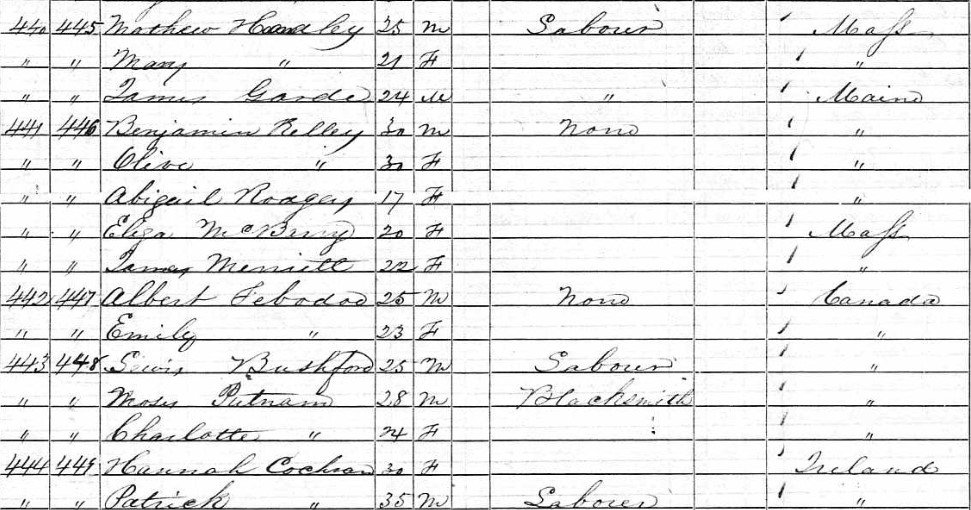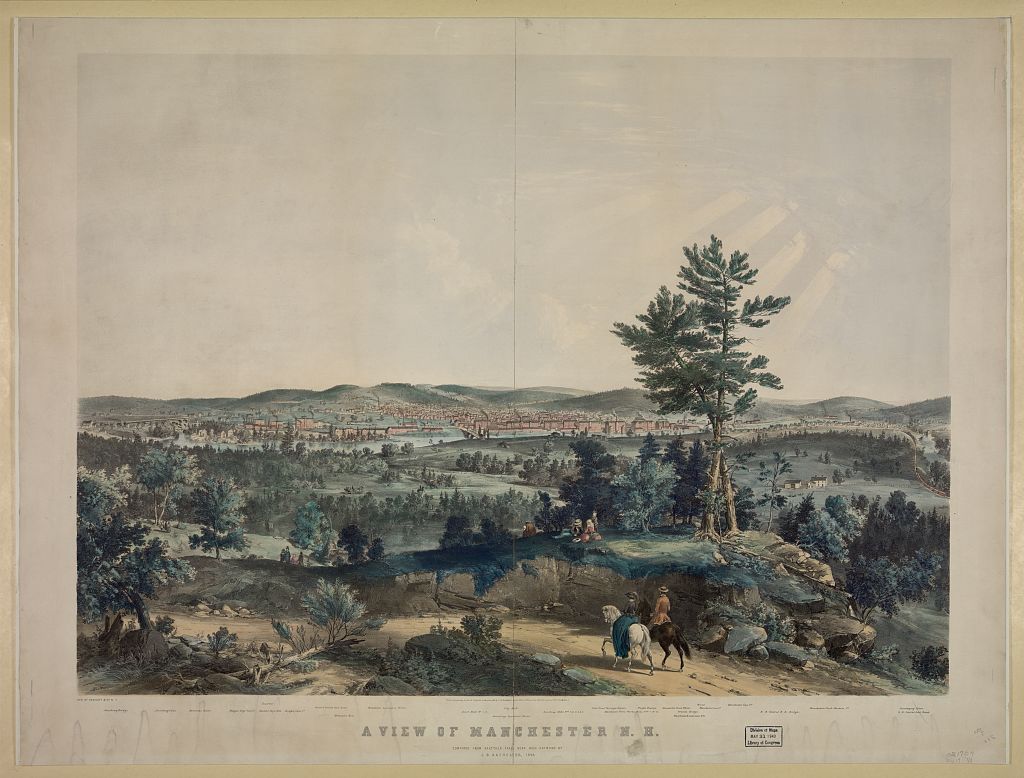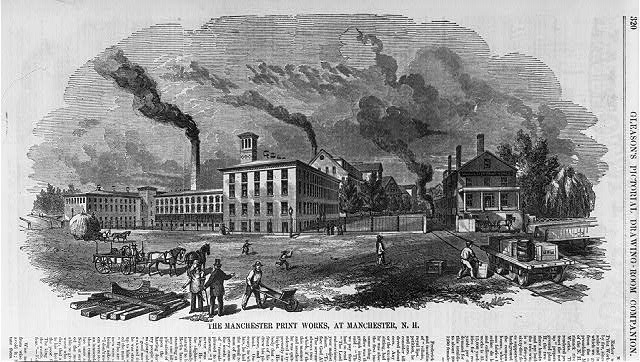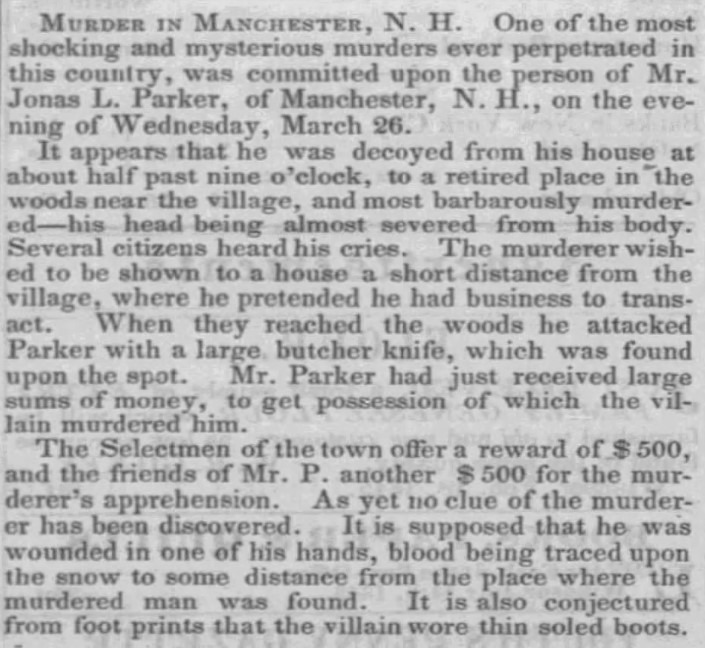On June 29, 1935, a special issue of the French-language newspaper in Manchester, New Hampshire, L’Avenir national, celebrated la Saint-Jean-Baptiste. Some articles chronicled great figures in Quebec history. Most, however, were firmly focused on the French Canadians of Manchester. In keeping with the occasion, the articles marked with undisguised pride the achievements of their community. From the factory floor to city hall, francophones had made Manchester their home in the fullest sense of the word.
If not for this special issue and at most a handful of historical works, it would be easy to miss just how long people of French-Canadian descent had lived in Manchester by the 1930s. Father Edouard Hamon’s landmark work from the 1890s can be misleading: in nearly all large factory cities where a Little Canada sprang up, the first national or ethnic parish was founded only after the U.S. Civil War. Some authors have tentatively argued that French Canadians would have been part of the labor force that built textile mills in the first place. Although this will require further research, there is no question that Lowell and Manchester began to appear as destinations in Lower Canada’s documentary record in the 1840s. The special issue of L’Avenir national, based on prior research, confirms the earlier dates. In one article titled “Les Pionniers Canadiens de Manchester” (p. 6), the unnamed author retrieved the following names from Manchester city directories. This is likely the first English translation.
1845
On page 54, we find the name of John Durant, a mechanic employed at the Amoskeag. This name is probably English, for in the records of city hall there is mention of a certain John Durant who in 1846 married a young person who was English-speaking.
On page 72, we find a name that is truly French-Canadian. It is that of Mr. J. C. Jacques, blacksmith, employed at the Amoskeag and residing in the Machine Shop Block.
A section on the Amoskeag’s employees occupies many pages, but, oddly, we do not find a Canadian name. The directory’s author takes one page to indicate that the book is not complete and that it contains only 3,000 names. Manchester’s population then amounted to at least 10,000. It is therefore not surprising that the French names were omitted. In this period, the directory was published only every two years.

1846
We again spy the name of Mr. Jérémie Jacques, blacksmith, domiciled in the Machine Shop Block. We then find the names of Maria, Elizabeth, and Rosilda Raymond, all three employed in the Amoskeag textile factories.
The name of Mr. Albert Thibaudeau (Tebodo) is easily recognizable. Mr. Thibaudeau is evidently the one who, on December 5, 1841, married Miss Amélia Rochefort before the Rev. Gage . . .
1848
The directory for this year contains the following names:
- Patience Allard, employed in the Amoskeag textile factories.
- Paul Beaulieu (Paul Bealreu), 48 Stark Co.
- François Bourassa (Francis Brasso), 25 Amoskeag Co.
- Léonard Desmarais (Desmary), West Concord Street.
- Marie and Sophie Lacourse, 75 Amoskeag Co.
- Mary Jacques, 41 Machine Shop Block.
- John St-Pierre (St. Peter), 68 Amoskeag Co.
1850
French names in this directory are those of:
- François and Marguerite Bourassa, employed in the Amoskeag textile factories and residing at no. 8 Amoskeag Co.
- Adéline, Adélia, and Rosanna Clément, 25 Stark Co.
- John Roy, 21 Print Works.
- Edouard Bois, Piscataquog.
1852
It has been claimed, erroneously, that the first Canadian physician in Manchester was Dr. A. L. Tremblay, who died in this city in 1877. Three Canadian Asclepii had already visited our city prior to 1867. Mr. Emile H. Tardivel mentions in his Guide des Canadiens a Dr. Bélisle who would have resided in Manchester around 1854—according to several older citizens—and his writing is fairly exact. However, Dr. Bélisle was not the first to try his luck in our city. That was Dr. Joseph A. Parent who, in 1852, had his offices at 20 Amherst Street. Dr. Parent was, according to the archives of the New Hampshire Medical Society, one of its members. He must not have been satisfied with his lot, for the directory of addresses makes no mention of his name in 1854.
We then find the names of Louis and Edouard Paris, employed in the factories . . .
A Mr. Salomon Tobie, of Janesville, produced soap in these years. Several of our older citizens knew this man.
1854
In this year, we find the name of the first Canadian milliner, Miss Laura Clément, who resided at 47 Elm Street, at the corner of Amherst.

1856
We see in this directory the name of Dr. Edouard T. Bélisle, whom Mr. Tardivel mentions in his guide. He has his offices at 3 Granite Block and his residence at 12 Manchester Street.
There was also a Dr. Labarre (Labore) who claimed to have spent thirty years in hospitals in England . . .
We also find the name of Mr. Joseph Pelletier, owner of a boarding house.
1858
Dr. Elzéar Provencher resided at 39 Manchester Street, but evidently business was not booming, for he soon left the city.
In this year, Benjamin Millette, a Canadian daguerreotypist, opened a workshop at 79 Elm Street after taking his residence at 21 Pine Street, at the intersection with Manchester Street. Mr. Millette was thus the first photographer of our nationality to establish himself in Manchester. It was therefore not, as had been suspected, Mr. Olivier Desmarais, who came to live in Manchester around 1882. Mr. Millette left the city in 1860.
Mr. Ernest Blum, French instructor, who gave lessons at 2 Mercantile Block. He left two years later.
1862
Mr. Nazaire Laflotte joined the Barton Store. Mr. Laflotte was probably the first French-Canadian store clerk in Manchester. The next year, a certain Joseph Duval went into the grocery and liquor business.
In 1865, Mr. Siméon [Roy dit] Desjardins became owner of a bar on Elm Street. Mr. Desjardins had the unfortunate habit of translating his name to King. The next year, he opened a shoe store on Elm Street between Bridge Street and Kidder Court.
* * *
Another article in L’Avenir national, “Les Canadiens à Manchester – Manchester, Centre Canadien” (pp. 17-18), also probed the beginnings of the French-Canadian community. It relied on city registers, other public records, and statements of older citizens. The original source is not given, but, considering the age given for Marie Jutras, it may well have been a patchwork including Tardivel’s Guide and slightly later publications. An excerpt:
All of the documents we consulted agree that Mr. Hyacinthe Jutras, who died in 1893, was one of our first compatriots to settle within the bounds of this city. Everyone knew him, at one time, and, perhaps more than anyone else, he helped shed light on the beginnings of our colony. We read in the registers of city hall that Mr. Jutras was in Manchester on October 8, 1848, as he served as a witness at the wedding of Mr. Louis Bonin (Bonner) and Miss Henriette Bonenfant (Harriet Goodchild). The maid of honor was Miss Catherine Bonenfant. In this case the French name appears in the register.
But prior to this period there had been Canadians in Manchester. Louis Bonin arrived in Manchester in 1833. After spending many years in this city, he returned to Canada, then came back to Manchester about sixty years ago. He spent a few years here and went to Clifton, where he died. If this information is correct, as we have reason to believe, Mr. Bonin has the honor of being the first to establish himself in our city . . .

The First Marriage
It is however certain that French Canadians married in Manchester in 1839. The first marriage that appears in city registers is that of Mr. Louis Marchand and Miss Sarah Robert . . .
The First Birth
The first mention of a child born to Canadian parents comes on July 16, 1852, in the family of Mr. and Mrs. Cyrille Lebrun. The next year, on December 9, registers show the birth of a girl in the family of Mr. and Mrs. Michel and Lucie Anne Hévey. In this era, physicians did not bother to register the births of children born to Canadian parents. In a few cases, they were content to state at such-and-such date, a boy or a girl had come into the world at a Frenchman’s dwelling.
The First Death
The first death in a Canadian family that was registered at the town office is that of Mr. John Jacques’ wife, dated January 11, 1853 . . .
The Old Registers
The marriage of John McCauley, in 1844, a Canadian despite his Irish name, corroborates the statement of alderman Larivière, of the old ninth ward, who tells us that his uncle, Mr. J. P. Larivière, came to Manchester before 1844 alongside Mr. Hyacinthe Jutras and Mr. Sam McCauley. There were several Canadian families in our city then.
In his Guide des Canadiens-Français, published in 1894-1895, attorney Emile H. Tardivel lists, among the oldest residents of our nationality, Messrs. Jean Biron, Cyrille Lebrun, Télesphore Lemire—who died in Stoke Center, Quebec, in 1891—, and the aforenamed Nazaire Laflotte and Janelle and Joseph Bérard (alias Bell), who came and settled in this city around 1848 . . .
[Michel] Côté came from Stanstead, Quebec, on March 25, 1845, the day of the murder of Mr. Parker, tax collector for the village of Manchester. Mr. Côté was among those who, in 1849, chopped down the trees where the church of St. Anne, the oldest Catholic temple in the city, now stands.
At Mr. Côté’s arrival, many Canadian families resided in Manchester. One of the oldest was that of Mr. Pierre Bonenfant, who was domiciled in “new village” or the block of houses built in the vicinity of the Amoskeag textile factories . . .
Mrs. Marie Jutras, later of Haverhill, Mass., aged 90 or 91, operated a boarding house at Skeag around 1830 . . .

The First Mass
The first mass to be celebrated by a priest of our nationality was quite an event. A priest named Lévesque [almost certainly the missionary Zéphirin] passed through the city during the fall of 1849. Mass was celebrated in a wooden structure that served as a school. Vehicles were kept on the lower floor. The aforementioned Marie Jutras, who was connected to the Côté family, was in attendance at this mass. The hall was filled with French Canadians; many Irish were also present. The ceremony wasn’t over that the floor collapsed. One Baptiste Côté fell on a vehicle and injured his shoulder. The section of the floor holding the priest and the altar stayed put.
Pastor William McDonald, the first resident Catholic priest of Manchester, had been in the city about five years, at this time. The visit of a French-Canadian priest had nevertheless been saluted with great joy by our compatriots.
Father Noiseux, who died several years ago in Littleton, often visited the Canadians around 1850 and after. The saintly missionary brought the consolations of religion to nearly all French-speaking populations in New Hampshire, Vermont, and Maine.
Then follows a much thorough list of acts—nearly one hundred in all—involving French Canadians from 1839 to 1861.
Pingback: This week's crème de la crème - September 14, 2024 - Genealogy à la carteGenealogy à la carte
Thank you Patrick. Rev, Father Isidore H Noiseux is credited with being a very dedicated missionary. I wonder why his name is not given more attention.
Pingback: Friday’s Family History Finds | Empty Branches on the Family Tree
My great-grandfather Antoine Plourde was born there in 1874. I always wondered about why his family came to be there.